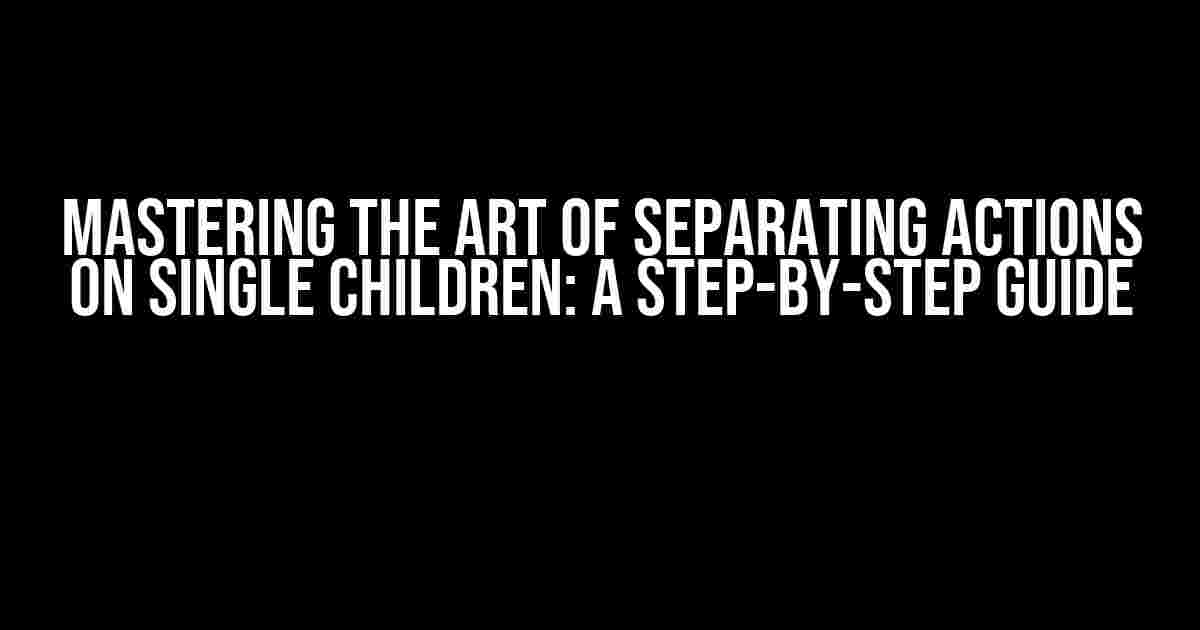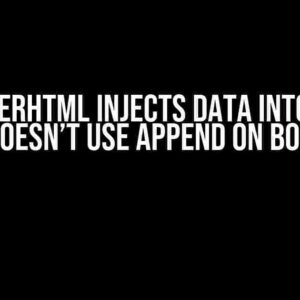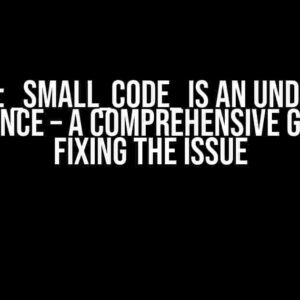Are you tired of struggling to separate actions on single children when using the same function? Do you find yourself stuck in a web of confusion, unsure of how to approach this common problem? Fear not, dear developer, for we’ve got you covered! In this comprehensive guide, we’ll take you by the hand and walk you through the process of separating actions on single children with ease.
Understanding the Problem
Before we dive into the solutions, let’s take a step back and understand the problem at hand. When using the same function to perform different actions on multiple children, it can get messy quickly. Imagine having a function that toggles the visibility of multiple elements on a page. Without proper separation, you might end up with a function that’s difficult to maintain, debug, and scale.
So, what’s the solution? The answer lies in creating separate actions for each child, while still utilizing the same function. Sounds confusing? Don’t worry, we’ll break it down for you.
Using Event Delegation
One of the most effective ways to separate actions on single children is by using event delegation. This technique involves attaching an event listener to a parent element, and then using the target property to determine which child element triggered the event.
// Get the parent element
const parent = document.getElementById('parent');
// Attach an event listener to the parent
parent.addEventListener('click', (e) => {
// Get the target element
const target = e.target;
// Check if the target is a child element
if (target父parent === parent) {
// Perform the desired action on the target element
switch (target.className) {
case 'child-1':
console.log('Child 1 was clicked!');
break;
case 'child-2':
console.log('Child 2 was clicked!');
break;
default:
console.log('Unknown child element clicked!');
}
}
});
In this example, we attach an event listener to the parent element, and then use a switch statement to determine which child element was clicked. This approach is efficient and scalable, as you can add or remove child elements without modifying the function.
Using Data Attributes
Another approach to separating actions on single children is by using data attributes. This involves adding custom data attributes to each child element, and then using those attributes to determine the action to take.
// Get the parent element
const parent = document.getElementById('parent');
// Attach an event listener to the parent
parent.addEventListener('click', (e) => {
// Get the target element
const target = e.target;
// Get the data attribute of the target element
const action = target.dataset.action;
// Perform the desired action
switch (action) {
case 'show':
console.log('Showing the element!');
break;
case 'hide':
console.log('Hiding the element!');
break;
default:
console.log('Unknown action!');
}
});
In this example, we add custom data attributes to each child element, indicating the action to take when clicked. We then use the dataset property to retrieve the data attribute, and perform the desired action based on its value.
Using a Config Object
A more advanced approach to separating actions on single children is by using a configuration object. This involves creating an object that maps each child element to a specific action, and then using that object to determine the action to take.
// Create a config object
const config = {
'child-1': () => console.log('Child 1 was clicked!'),
'child-2': () => console.log('Child 2 was clicked!')
};
// Get the parent element
const parent = document.getElementById('parent');
// Attach an event listener to the parent
parent.addEventListener('click', (e) => {
// Get the target element
const target = e.target;
// Get the config function for the target element
const action = config[target.className];
// Perform the desired action
if (action) {
action();
} else {
console.log('Unknown child element clicked!');
}
});
In this example, we create a config object that maps each child element to a specific action. We then use the className property to retrieve the corresponding action function, and execute it when the child element is clicked.
Best Practices
Now that we’ve explored different approaches to separating actions on single children, let’s discuss some best practices to keep in mind:
- Keep it simple: Avoid over-complicating your code with complex logic or nested conditionals. Instead, focus on creating a simple and elegant solution that’s easy to maintain.
- Use meaningful variable names: Choose variable names that accurately reflect their purpose and functionality. This will make your code easier to read and understand.
- Test thoroughly: Make sure to test your code thoroughly to ensure that it works as expected. Use different scenarios and edge cases to test your code’s robustness.
- Keep it modular: Break down your code into smaller, reusable modules that can be easily maintained and updated.
Common Pitfalls
When separating actions on single children, there are several common pitfalls to avoid:
- Over-nesting: Avoid nesting multiple conditional statements or functions within each other. This can lead to code that’s difficult to read and maintain.
- Duplicate code: Avoid duplicating code for each child element. Instead, focus on creating a single function that can be reused across multiple elements.
- Hardcoding: Avoid hardcoding values or actions for each child element. Instead, use data attributes or config objects to make your code more flexible and scalable.
Conclusion
In conclusion, separating actions on single children when using the same function requires careful planning and implementation. By using event delegation, data attributes, or config objects, you can create scalable and maintainable code that’s easy to understand and modify. Remember to follow best practices, avoid common pitfalls, and test your code thoroughly to ensure that it works as expected.
| Approach | Description |
|---|---|
| Event Delegation | Attach an event listener to a parent element and use the target property to determine which child element triggered the event. |
| Data Attributes | Add custom data attributes to each child element and use those attributes to determine the action to take. |
| Config Object | Create a config object that maps each child element to a specific action and use that object to determine the action to take. |
By mastering the art of separating actions on single children, you’ll be able to write more efficient, scalable, and maintainable code that will make your life as a developer much easier. Happy coding!
Frequently Asked Question
Are you tired of dealing with the chaos of multiple children calling the same function? Don’t worry, we’ve got you covered! Here are the top 5 questions and answers on how to separate actions on a single child when using the same function:
Q1: How do I know which child is calling the function?
A1: You can pass a unique identifier or a reference to the child as an argument to the function. This way, the function can determine which child is calling it and take the appropriate action.
Q2: Can I use the same function for different children with different actions?
A2: Absolutely! You can use a switch statement or an if-else block to execute different actions based on the child that calls the function. Just make sure to pass a unique identifier or a reference to the child as an argument.
Q3: What if I have a large number of children calling the same function?
A3: In that case, you can use an object or an array to store the actions for each child and access them using the child’s unique identifier. This way, you can easily manage and separate the actions for each child.
Q4: Can I use event listeners to separate actions for each child?
A4: Yes, you can! Event listeners are a great way to separate actions for each child. You can attach a unique event listener to each child and execute the corresponding action when the event is triggered.
Q5: How do I prevent conflicts between children calling the same function?
A5: To prevent conflicts, make sure to use a unique identifier or a reference to the child as an argument to the function. This way, the function can determine which child is calling it and take the appropriate action without conflicts.






